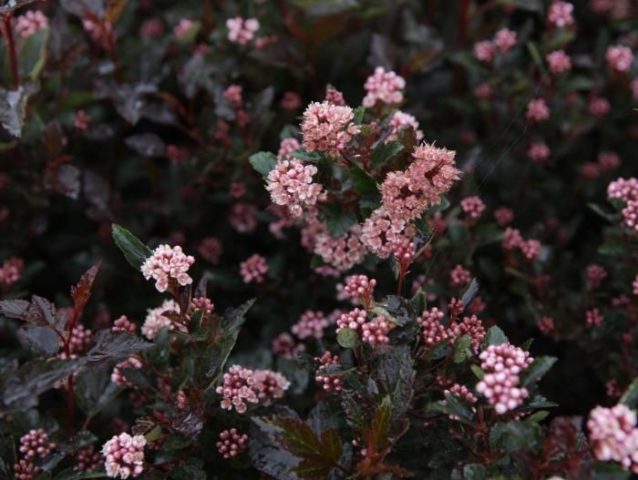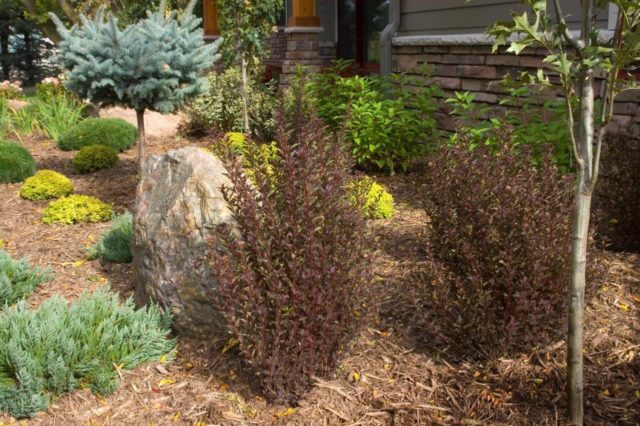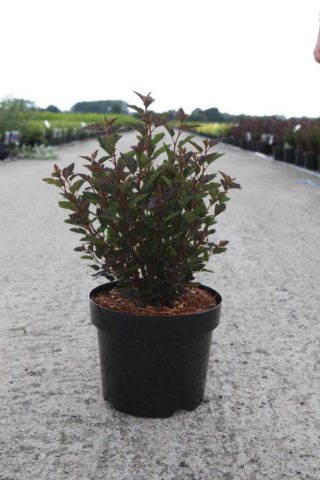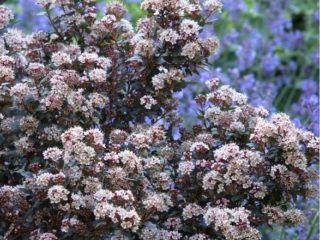Content
Unpretentious plants are always valued by gardeners, especially if they are unusual and versatile. Little Devil's bladderwort can become a real highlight of the garden on its own or in tandem with other plants.
Description of the Little Devil bladderwort
The genus Bladderwort (in Latin Physocarpus) is a plant of the Rosaceae family, native to North America. It has been grown in our latitudes since 1793. The name comes from the shape of the fruit: “physo” - “bubble”, “carpos” - “fruit”.
A deciduous shrub of miniature size, Little Devil (Physocarpus opulifolius Little Devil) is one of the low-growing varieties of the species. An adult plant can be 80 cm in height, maximum - 1 m. Spreading branches grow in a vertical direction, looking up. They create a spherical crown, the diameter of which reaches from 70 to 90 cm.
The neat little devil carp bush has graceful, narrow leaves with 3 to 5 serrated lobes of a dark burgundy color, in an alternate arrangement. The unusual color of the crop does not change throughout the season. If you plant the plant in a shady location, they will change from dark burgundy to green with a slight purple tint.
Small pinkish-white flowers are collected in corymbose inflorescences with a diameter of about 3 - 4 cm. There are many of them, they appear in June. Little Devil's bladderwort blooms for 2 - 3 weeks. Its fruits appear in September-October and are swollen purple leaflets.
You can see what a blooming Little Devil vesicle looks like in the photo:
Little Devil vesicle in landscape design
Standing out in a group next to other shrubs, the crop is often used to decorate the edges of flower beds and flower beds, as well as in compositions with various coniferous and herbaceous plants.
Bushes of several varieties with multi-colored leaves - yellow, green and red - look very impressive. Little Devil's vesicle is also used as geometric borders 40 - 50 cm high, as well as low hedges.
Conditions for growing Little Devil bladderwort
The growing conditions for such an unpretentious plant as Little Devil's bladderwort are quite modest:
- It feels comfortable in gas-polluted conditions; for example, it grows quietly along roads.
- Refers to light-loving. It also develops well in shaded areas, but the leaves lose their bright color and become green.
- Grows in almost any type of soil with good drainage and moderate moisture. Fertile sandy and loamy soils without lime, with an acidic or neutral alkaline environment are preferable for the Little Devil vesicle. The plant will look richer on them.
Planting and caring for Little Devil's bladderwort
The Little Devil plant is unpretentious, but it is better to follow the basic rules of agricultural technology, and then this perennial bush (whose age reaches 20 - 25 years) will grow quickly and retain its unusual color. Providing proper care is not difficult; it consists of timely watering, fertilizing, and pruning.
Preparing the landing site
The prepared place for Little Devil viburnum should be free from trees or other objects that can create shadow. The unusual color of the leaves will remain only with direct access to sunlight.
Planting of several bushes is carried out based on the norm of 10 - 25 pieces per 1 m2. The distance between plants is left 0.8 m so that the crown grows freely.
Landing rules
A plant from a container can be planted throughout the growing season. A bare-root bush is planted only before the leaves appear in spring or early fall. It is recommended to first soak the roots of the Little Devil vesicle in water for several hours (2 - 5), and only then plant them in the ground.
Main stages of planting:
- The depth of the planting hole should be about 50 - 60 cm. Peat soil or humus is poured into it 1/3 heaped, the roots are straightened without deepening the root collar.
- Then the bush is covered with soil, slightly pressing it down.This is necessary so that the dormant buds in the lower part of the plant wake up and produce additional shoots.
- The planted bush is watered abundantly.
- After all the manipulations, all that remains is to mulch the root circle with straw, pine needles or dry grass. Mulching prevents crust from forming on the surface, thereby ensuring constant aeration of the roots. In addition, mulch retains water and nutrients.
Watering and fertilizing
In the first case, take 0.5 kg of mullein or bird droppings per 1 bucket of water and add 1 liter of weed infusion/2 tbsp. l. urea and saltpeter. Other nitrogen fertilizers can be used to stimulate plant growth.
In autumn, the purpose of feeding is different - to nourish the plant. To do this, infuse 1 tbsp in a bucket of water. wood ash or use alternative mineral fertilizers, for example, 1 tbsp. l. Nitroammophoska, which is added to 1 bucket of water.
Water with solutions containing fertilizer at the rate of 15 liters per plant (a couple of buckets).
Little Devil's bladderwort, growing on light sandstone, sandstone or loam, must be watered regularly in dry and hot summers. An adult plant will need 4 - 5 buckets of water 2 or 3 times a week.
If the soil type is completely opposite (heavy clay) or the bush is located on a lawn, it is important to observe moderation. Excess water should not be allowed, otherwise it will lead to powdery mildew and death of the bush.
Trimming
If the Little Devil vesicle is in a sunny area and has dark burgundy leaves, you need to remove any green shoots that appear.
The shoots of young plants will branch better if they are pruned regularly. In addition, if Little Devil's bladderwort is not pruned at all, it will resemble a fountain in shape. To get a wide multi-stemmed bush, its maximum height should be no more than 50 cm. To form a vertically growing vesicle, thin stems growing from the base are cut out. Leave a maximum of 5 of the strongest branches. They are also pruned to stimulate growth after reaching a height of 1.5 m. This should be done in early spring (before the first leaves appear), and then again at the end of the growing season in the fall.
Little Devil's bladderwort tolerates annual pruning and pruning quite calmly; young shoots immediately appear on the bush.
Every spring it is necessary to remove dried, broken or frozen branches.
Preparing for winter
In winter, it is recommended to mulch the root circle. Little Devil's bladderwort can withstand frost; there is no need to cover an adult bush, but at low temperatures the shoots, especially young ones, may freeze.
Reproduction of Little Devil.
Little Devil viburnum is propagated by seeds, cuttings, layering or by dividing the bush.
Seeds are sown after they are collected in October-November. It would not be superfluous to stratify them for 2 months at a temperature of 5 oC. Gardeners rarely use this method, because not every seedling results in an unusual foliage color.
It is recommended to divide an overgrown Viburnum vesiculus bush in spring or autumn.In the summer, only experienced gardeners will be able to carry out the procedure correctly.
The main method of crop propagation is considered to be vegetative.
By layering
Select beautiful and healthy young branches, cut off all the leaves from them, except 2 - 3 at the top. Small grooves with a depth of no more than 15 cm are made in the ground next to the bush. The cuttings are bent, placed in prepared recesses and secured with wooden brackets in several places.
The best time is the beginning of spring. During the growing season, the cuttings will have time to take root. If the summer turns out to be dry, the soil must be constantly moistened. In autumn, young bushes are separated from the mother bushes. In the first year of wintering, young plants must be covered.
Cuttings
Green cuttings 20 cm long are cut from the bush in the second half of summer. Each one should have at least 4 - 5 buds (two of them will later form roots, and the other two or three will form above-ground shoots).
First, the cuttings are placed for several hours in a solution with a root growth stimulator, and then in soil made of sand and peat. Instead of peat, you can use river sand. It is important to create a favorable microclimate. To do this, the cuttings are covered with film or each is covered with a plastic bottle with the neck cut off.
Then there are two options - keep them indoors until spring and wait for the new season. The second way is to immediately plant it in a shaded area of the garden. In winter, shoots that have not yet become strong should be covered. The young Little Devil vesicle, having survived the frost, can already be planted on the site in a permanent place.
Diseases and pests
Little Devil viburnum is resistant to diseases and pests.Powdery mildew can attack a bush only if it is over-watered.
Conclusion
Little Devil is a charming “little devil” that is not demanding and is resistant to diseases and adverse factors. A neat bush will add colour, and is great for creating low purple hedges, borders and contrasting groups.











